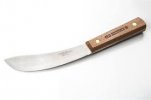- Joined
- May 1, 2010
- Messages
- 35
Does anyone have experience specifically with skinning? I tried to skin a hog with my spyderco sage because it was in my pocket at the time, but it had a fairly polished edge (6k, stropped with flitz polish) and didn't work as well as the cheap butcher knives lying around the skinning rack.They seemed to have coarse edges and the guy I was skinning with used a steel to bring the edge back a couple times (hog skin is quite tough).
I have a Spyderco Gayle Bradley that I want to set up for skinning. I'm thinking about putting either a 320 or 1000 grit edge on it with my shapton glass/suehiro waterstones. Does that sound right for a skinning knife? What do you guys do?
I have a Spyderco Gayle Bradley that I want to set up for skinning. I'm thinking about putting either a 320 or 1000 grit edge on it with my shapton glass/suehiro waterstones. Does that sound right for a skinning knife? What do you guys do?

